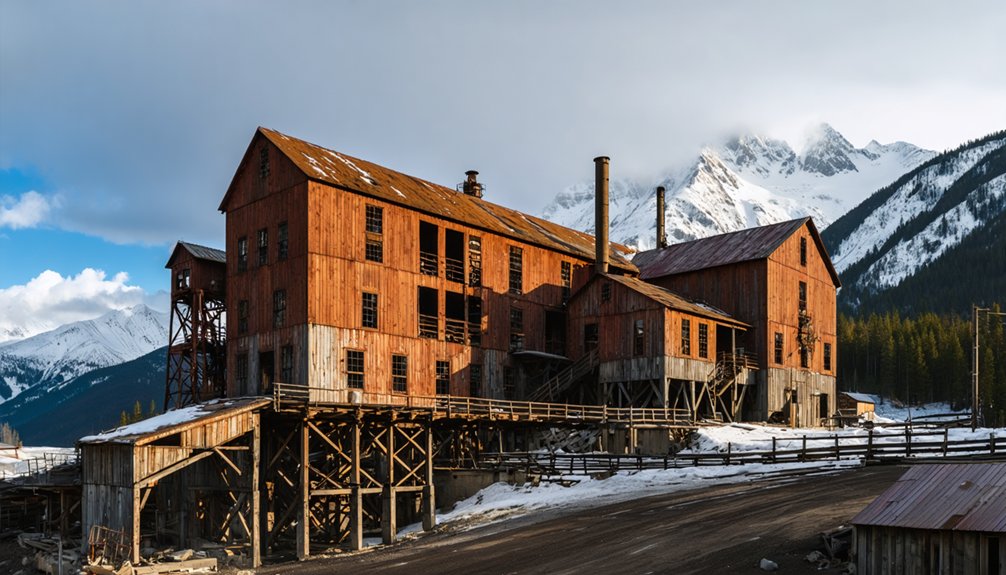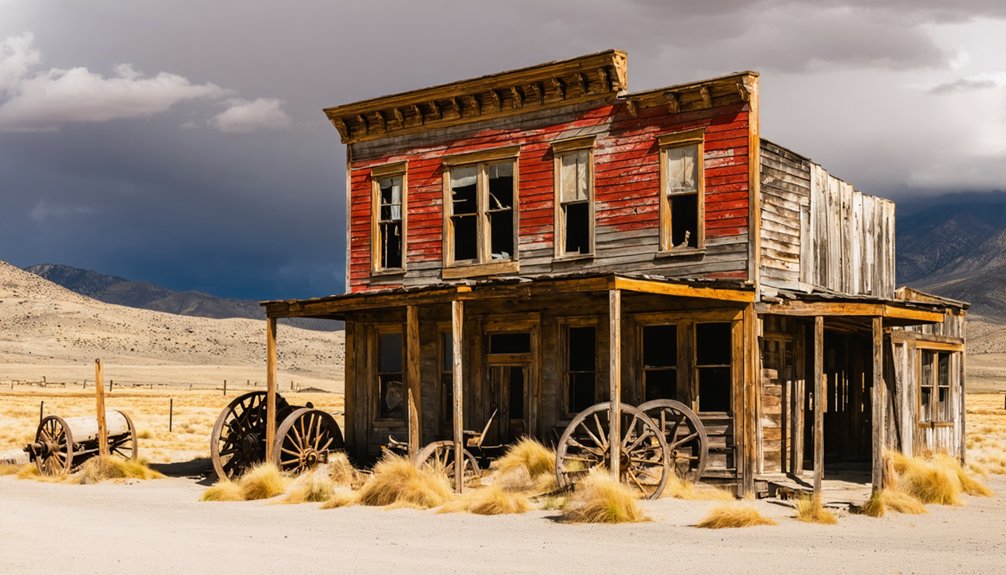You’ll find fascinating ghost towns worldwide where history stands frozen in time. Explore Bodie’s gold rush buildings in “arrested decay,” Pripyat’s post-Chernobyl landscape, Kolmanskop’s sand-filled mansions, Hashima Island’s concrete ruins, St. Elmo’s pristine frontier structures, Centralia’s smoldering streets, Kennecott’s remote copper relics, and Virginia City’s Victorian architecture. Each abandoned settlement offers a unique glimpse into bygone eras where dreams once flourished before time reclaimed them.
Key Takeaways
- Bodie, California offers an authentic gold rush experience with 110 original structures preserved in “arrested decay.”
- St. Elmo, Colorado features 43 original structures from the 1880s and is recognized on the National Register of Historic Places.
- Virginia City attracts visitors with haunted locations, ghost tours, and $400 million worth of silver mining history.
- Centralia, Pennsylvania showcases the effects of a continuous underground coal fire burning since 1962.
- Kolmanskop, Namibia and Hashima Island, Japan represent international ghost towns reclaimed by natural elements.
Bodie, California: A Gold Rush Time Capsule
While many ghost towns fade from memory, Bodie stands frozen in time as one of America’s most authentic abandoned settlements. Following an 1859 gold discovery and subsequent 1876 mining boom, this once-lawless town swelled to 8,000 residents before declining as fortunes dwindled.
You’ll walk among roughly 110 structures preserved in “arrested decay”—not restored but maintained exactly as they were left. Peek through windows to see interiors still stocked with original goods and furniture. The profound silence is occasionally broken only by wind and gravel underfoot, creating a uniquely immersive historical experience. This page serves as a disambiguation resource for visitors seeking specific information about various locations named Bodie.
The California State Historic Park status protects this Gold Rush time capsule from souvenir hunters and commercialization.
Visit year-round (though winter requires snow-ready vehicles) to experience genuine Western history without gift shops or reenactments. As you explore, you’re witnessing historic preservation at its most authentic—a rare glimpse into America’s frontier past.
Pripyat, Ukraine: Frozen in the Nuclear Age
Unlike most abandoned places, Pripyat stands as a haunting monument to the nuclear age, abruptly frozen in time since the 1986 Chernobyl disaster. This Soviet “atomgrad” once bustled with nearly 50,000 residents before radiation forced their permanent evacuation within hours. Average radiation levels remain several times higher than typical background levels, with numerous hotspots scattered throughout the area.
If you’re drawn to urban exploration, Pripyat offers a surreal glimpse into Soviet life suddenly halted:
- Visit the iconic abandoned amusement park with its never-used Ferris wheel
- Explore decaying apartment blocks still containing personal belongings
- Witness nature reclaiming the city as wildlife thrives in humanity’s absence
- Experience the eerie silence of empty schools with books still open on desks
Today, you can access this time capsule only through guided tours with strict radiation protocols. The site is estimated to remain unsafe for humans for approximately 20,000 years.
Kolmanskop, Namibia: Swallowed by Desert Sands
The shifting dunes of Namibia’s Namib Desert tell a different tale of abandonment than Pripyat’s nuclear tragedy. Just 10 kilometers inland from Lüderitz, you’ll find Kolmanskop—once a thriving diamond mining town that produced over 5 million carats before being reclaimed by sand.
In its heyday, this German colonial settlement boasted luxuries unimaginable in such a remote location: a hospital with southern Africa’s first X-ray machine, an ice factory, and elegant mansions. The town even featured a concert hall and casino where residents enjoyed entertainment despite their remote location.
You’ll marvel at the abandoned architecture as you wander through sand-filled rooms where wealthy miners once lived. At its peak, the town reached astonishing wealth levels, with Kolmanskop having the highest per capita wealth in the world.
After richer diamond deposits were discovered further south in 1928, Kolmanskop’s decline began.
Today, desert preservation efforts by Namdeb allow you to explore this haunting monument to colonial wealth and nature’s persistent reclamation.
Hashima Island, Japan: The Concrete Battleship
Rising ominously from the waters of Nagasaki Prefecture, Hashima Island stands as a haunting memorial to Japan’s rapid industrialization and subsequent decline.
Once home to over 5,000 people crammed into concrete apartments, this abandoned coal mining facility earned its “Battleship Island” nickname from its distinctive silhouette and massive seawalls.
When you visit this controversial industrial heritage site, you’ll encounter:
- Crumbling nine-story concrete structures that housed miners and their families
- The remnants of Japan’s first large reinforced concrete building, constructed in 1916
- Designated walkways protecting you from dangerous ruins that continue to deteriorate
- Visual reminders of the island’s complex wartime legacy, where Korean and Chinese forced laborers suffered under harsh conditions
The island was completely evacuated after Mitsubishi shut down operations in 1974, with residents leaving many personal belongings behind.
This UNESCO World Heritage site opened for limited tours in 2009 after 35 years of abandonment. Access remains restricted to only about 95% of the island due to serious safety concerns as the aging structures are at risk of collapse.
St. Elmo, Colorado: The Best-Preserved Ghost Town in America
You’ll be transported back to the 1880s mining boom when you visit St. Elmo, where over 43 original structures stand amid breathtaking Rocky Mountain scenery.
This well-preserved ghost town offers a rare glimpse into authentic frontier life with its operational general store, historic schoolhouse, and mining artifacts still visible throughout the settlement. Named after a 19th-century romantic novel, St. Elmo was originally called Forest City before receiving its current name from town founder Griffith Evans.
Interpretive kiosks throughout the town provide visitors with detailed historical context about building uses, restoration techniques, and the importance of staying on designated paths.
Whether blanketed in pristine winter snow or adorned with summer wildflowers, St. Elmo rewards photographers with stunning vistas and architectural details that capture the spirit of Colorado’s golden age.
Mountain Mining Marvel
Nestled at 10,000 feet in Colorado’s Sawatch Range, St. Elmo offers you an authentic glimpse into America’s mining heritage.
Once bustling with 2,000 residents during the 1880s gold and silver boom, this remarkably preserved ghost town now stands as a monument to western frontier ambition. The Mary Murphy Mine’s rich deposits fueled St. Elmo’s rapid growth before eventual abandonment in the 1920s.
Today, you’ll discover:
- 43 surviving original structures including storefronts, homes, and community buildings
- Well-maintained roads allowing year-round access to this alpine treasure
- Historic buildings that once housed saloons, hotels, and the town newspaper
- Opportunities for photography, hiking, and exploring the surrounding backcountry
Don’t miss this chance to wander freely through Colorado’s mining past, where mountain solitude has perfectly preserved a slice of American history.
Year-Round Photographic Paradise
St. Elmo rewards photographers with a visual feast unlike any other ghost town in America. You’ll find 43 original structures creating an authentic streetscape where early morning light dances across weathered wood, highlighting century-old nails and architectural details with golden precision.
Listed on the National Register of Historic Places, the town’s impeccable historical preservation allows you to capture the past through your lens year-round, thanks to four-season plowing and maintained access.
Advanced photographic techniques aren’t necessary—the town’s inherent textures, lichen-covered rocks, and aged porcelain create compelling compositions naturally.
Download a historical map before visiting to contextualize your shots, and compare today’s scenes with interpretive displays showing the town’s vibrant past.
Just remember to stay on established paths and respect private property while documenting this frozen moment in American history.
Centralia, Pennsylvania: The Town Still Burning Below
Beneath the cracked streets and abandoned buildings of Centralia, Pennsylvania, an inferno has raged unchecked since 1962, transforming this once-thriving coal mining town into an apocalyptic landscape.
This eerie ghost town‘s history was forever altered when a landfill fire ignited an underground coal seam that continues burning today.
If you’re brave enough to visit this haunting destination, be aware of:
- Ground temperatures reaching 900°F in some areas
- Toxic gases and smoke venting through fissures in the earth
- Dangerous sinkholes that have formed (one nearly claimed a 12-year-old in 1981)
- The infamous “Graffiti Highway” where nature and urban art collide
Once home to 1,300 residents, today only 5 people remain in this surreal reflection of mankind’s unintended consequences.
Kennecott, Alaska: Copper Riches in the Wilderness

Surrounded by vast Alaskan wilderness and towering glaciers, Kennecott stands as a remarkable tribute to America’s copper mining history. This once-thriving mining community produced some of the richest copper deposits ever discovered, generating over $100 million during its 27-year operation before closing in 1938.
You’ll find the town nestled deep within Wrangell-St. Elias National Park, where the National Park Service maintains the original mill, general store, and railroad depot.
As you explore this National Historic Landmark, you’ll sense the stark contrast between its booming past and quiet present. While Kennecott maintained strict prohibition rules, neighboring McCarthy offered miners forbidden pleasures just a short walk away.
The remote location that once challenged mining operations now draws visitors seeking both Kennecott history and Alaska’s untamed natural beauty.
Virginia City, Nevada: Where the Wild West Lives On
When you visit Virginia City, Nevada, you’ll discover a former silver boomtown that extracted over $400 million in precious metals from its legendary Comstock Lode while maintaining much of its Victorian architecture.
You can explore more than a dozen reportedly haunted locations, including historic chapels and bed-and-breakfast establishments that have been featured on paranormal television shows.
Unlike many mining towns that vanished completely, Virginia City transformed from an industrial powerhouse into a living museum where wooden-planked streets and preserved saloons offer an authentic glimpse into America’s bonanza mining heritage.
Bonanza Mining Heritage
Though many mining towns eventually faded into obscurity, Virginia City stands as a tribute to America’s most spectacular mineral rush. The legendary Comstock Lode, discovered in 1859, transformed this mountainside settlement into an industrial powerhouse through revolutionary mining innovations and unparalleled economic impact.
Silver extracted here even helped finance the Union during the Civil War.
When you visit, you’ll discover four key aspects of this bonanza legacy:
- The “Big Bonanza” of 1873 yielded over $300 million (billions in today’s dollars)
- Mining shafts extended an incredible 3,000 feet below ground
- The Bonanza Kings—Mackay, Flood, Fair, and O’Brien—extracted $3 million monthly at peak production
- Unlike true ghost towns, Virginia City maintained continuous habitation, preserving authentic Western heritage
Haunted Virginia City
Virginia City’s reputation as one of America’s most haunted destinations draws paranormal enthusiasts as enthusiastically as its Wild West history attracts history buffs.
As you stroll along wooden sidewalks, you’ll discover a “living ghost town” where the veil between worlds seems remarkably thin.
The infamous Old Washoe Club anchors the town’s ghost tours, offering chances to investigate rooms where apparitions frequently appear.
You can join paranormal investigations at the Mackay Mansion or Fourth Ward School, where unexplained sounds and shadowy figures await.
The town cemetery delivers particularly chilling encounters after sunset.
Beyond organized experiences, many visitors report unexpected encounters in saloons and historic buildings throughout town.
Virginia City’s blend of preserved 19th-century architecture and ghostly inhabitants creates an authentic atmosphere you’ll find nowhere else in the American West.
Preserved Victorian Architecture
While ghostly residents may captivate many visitors, the true soul of Virginia City reveals itself through its remarkable Victorian architecture.
After the devastating 1875 fire, the town rebuilt with stunning Italianate and Second Empire structures that stand proudly today as part of the Comstock Historic District.
You’ll marvel at the Victorian details that transport you to the 1870s boom era:
- Ornate woodwork and decorative brackets adorning the 400+ preserved buildings
- The majestic Second Empire-style Fourth Ward School with its distinctive roofline
- Elegant mansions along “millionaire’s row” on North B Street
- C Street’s historic storefronts with their original façades
Meticulous architectural preservation efforts have maintained authentic wooden-planked sidewalks while sensitively updating interiors, creating a rare living museum where the Wild West’s golden age endures.
Frequently Asked Questions
Are There Ghost Towns Accessible for People With Mobility Limitations?
Yes, you’ll find accessible ghost towns like Bodie, Castle Dome, and Escanaba offering mobility friendly tours with level pathways, boardwalks, and ADA-compliant options for your historic adventures.
Can Visitors Stay Overnight in Any of These Abandoned Towns?
Like stepping back in time, you can absolutely stay overnight in several ghost towns. You’ll find various accommodation options from historic cabins to hotels, though some require special overnight permits.
What Safety Precautions Should Be Taken When Visiting Radiation Zones?
You’ll need radiation monitors to track your exposure, protective suits, and proper safety gear. Always maximize distance from sources, minimize time spent, and follow decontamination procedures when exiting radiation zones.
Are There Ghost Towns Suitable for Visiting With Children?
Several spooky sites offer family friendly attractions where you’ll discover educational opportunities in places like St. Elmo, Bodie, and Virginia City. You’re free to explore these well-preserved historical treasures together.
How Do I Distinguish Between Authentic Artifacts and Staged Tourist Props?
You’ll recognize authentic artifacts by examining their antique identification markers—natural aging, craftsmanship irregularities, and original materials—while staged props lack historical context, provenance, and often use modern materials in conspicuous locations.
References
- https://www.visitouray.com/ghost-towns
- https://en.wikipedia.org/wiki/Wikipedia:WikiProject_Ghost_towns
- https://explorethearchive.com/western-ghost-towns
- https://www.thediscoverer.com/blog/7-abandoned-towns-around-the-world-you-can-actually-visit/YJW7NWfpMgAGbRg5
- https://albiongould.com/ghost-towns-to-visit-in-the-states/
- https://www.youtube.com/watch?v=w5XukL7jxZ8
- https://www.youtube.com/watch?v=9Q3IEfnUqyM
- https://en.wikipedia.org/wiki/Ghost_town
- https://www.tripadvisor.com/Articles-loOISRppph64-American_ghost_towns.html
- https://en.wikipedia.org/wiki/List_of_ghost_towns_by_country



